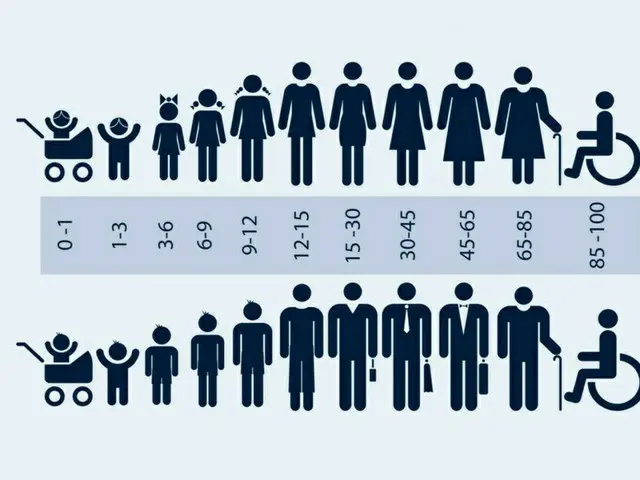The birth rate (births per woman, 0.76 people) was the lowest in history, and none of the 17 cities and prefectures in the country saw an increase in the total birth rate. Normally, the number of births is highest at the beginning of the year and tends to decrease toward the end of the year.
Taking this into account, the birth rate forecast for this year is also expected to hit a record low. According to the "March 2024 Population Trends Survey" released by the Statistics Korea on the 29th, the number of births in March was 19,669,
This is a decrease of 1,549 (7.3%) from a year ago. It is the first time since statistics began being released in 1981 that the number of births in March has fallen below 20,000.
Last year, the number of monthly births exceeded 20,000 until March 2023, but remained at the 10,000 mark from April to December.
The number of births in the first quarter was 60,474, down 3,994 (from the same period last year).
The total fertility rate in the first quarter was 0.76, down 0.06 from a year ago. This is also the lowest since Statistics Korea began providing quarterly total fertility rate data in 2009.
The total fertility rate (TFR) is the number of children that a woman of childbearing age is expected to have in her lifetime.
Considering the "beginning of the year effect" in birth numbers,
The annual total birth rate last year was 0.72, with the quarterly figures of 0.82 in the first quarter, 0.71 in the second quarter, and 0.65 in the fourth quarter.
Previously, in its "2022-2072 population estimates" released in December last year, Statistics Korea predicted that the total birth rate this year would fall to 0.68.
By region, the total birth rate in the first quarter decreased in 17 cities and provinces. Of these, Seoul's was down 0.04 from the same period last year.
The city of Sejong had the highest birth rate in the country at 1.10, but saw the largest decrease (0.1 person) compared to a year ago.
The birth rate by age group was down compared to the same month of the previous year for all age groups over 25 years old. In particular, the birth rate for those in their early 30s, the age group with the most childbirths, fell by 4.4 to 72.3.
The decline was the steepest in the number of women having only their first child. The trend of only having the first child continues. The proportion of women having their first child increased by 2.4 percentage points to 61.5%, while the proportion of women having their second child (31.7%) and those having three or more children (6.8%) were the largest.
The average length of marriage at the time of the first child's birth increased by 0.03 years to 2.53 years, indicating that people are increasingly having children later in life after marriage.
However, Statistics Korea expects that the number of births in the second half of this year may increase, based on the fact that the number of marriages has been on the rise for about a year since August 2022.
The number of marriages is considered a leading indicator of the birth rate. A Statistics Korea official said, "If this trend continues and the annual total birth rate falls to the first quarter level, it may end up being lower than the median estimate.
"There is a possibility that the number of births in the country may increase even higher than the medium standard," he said, explaining that "at present, it is impossible to predict."
The number of deaths in the first quarter was 93,626, down 4,650 (5.2%) from the same period last year.
The number of deaths exceeded the number of births, and the population in the first quarter decreased by 33,152 people. The natural decrease was larger than a year ago (minus 24,509 people).
The natural decline has continued for 53 months since November 2019. The South Korean government is making every effort to reverse the trend of low birth rates, which have not shown any signs of improvement despite the astronomical budgetary investments.
On the 9th, President Yoon Seok-yeol announced in his "2-year report to the nation under the Yoon Seok-yeol administration" that he would establish a new government planning department to deal with the declining birthrate (tentative name) and appoint the head of the department to serve as deputy prime minister and head of the human resources department.
The plan is to upgrade the Committee on Low Birthrates and Aging Society, which had remained an advisory body, to a ministry and agency to further advance measures to combat the declining birthrate.
Experts say that in order to change the low birth rate, which has already become a long-term trend, through policies, the perception of young people must change.
Professor Lee Cheol-hee of the Seoul National University Department of Economics said, "The policies that the government has mainly implemented so far, such as cash payments, support for childcare facilities, and the expansion of childcare leave, have not been effective.
"It is easy to see that the issue is being addressed, but there are aspects that are insufficient to reflect the overall change in society's perception of childbirth," he said. "Beyond reducing the cost of childbirth, there is also the issue of fierce social competition, social inequality, and an uncertain future.
We need to present a vision that can solve these problems."
2024/05/30 07:04 KST
Copyrights(C) Edaily wowkorea.jp 107

